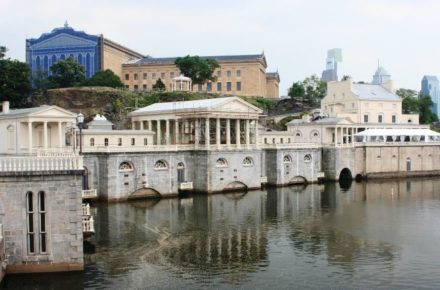
First Water Plant
Along the banks of the Schuylkill River, as you head into Philadelphia from the north, lies a unique Greek-style set of buildings. Those belong to the Fairmount Water Works – the first water plant in Pennsylvania and one of the earliest in the nation.
In 1801, the city was dealing with the aftermath of a yellow fever epidemic that killed thousands of people. City officials realized they needed a safe and reliable source of clean water to protect their citizens. Initially, the system used two steam engines to pump water from the Schuylkill; however, they were prone to breakdowns and were costly to operate. In 1815, the Fairmount Water Works began providing potable water for approximately 63 homes. The homes were connected to the reservoir, located on the hilltop now occupied by the Philadelphia Museum of Art, by wooden pipes.
The original water works still relied on steam engines until 1821, when a dam was constructed on the river at the plant. The dam turned water wheels that operated the pump, resulting in much greater efficiency and lower cost. Turbines were added between 1851 and 1871. The Fairmount Water Works operated until 1911, when it was decommissioned. Over the years, the buildings were used to house an aquarium and swimming pool. The site is now on the National Historic Register and houses the educational and historical exhibits of the Fairmount Water Works Interpretive Center.
The city’s water now comes from three water treatment plants that use slow sand filters to clean the river water. These plants are under the authority of Philadelphia Water (formerly known as the Philadelphia Water Department). They maintain the pipes and other infrastructure, making sure the more than 1.7 million residents of the city and surrounding suburbs have reliable, clean water. To learn more about the system today, click here.
